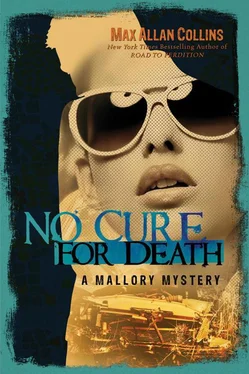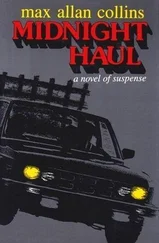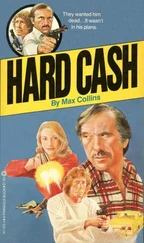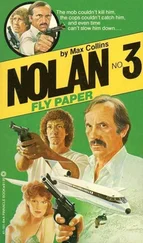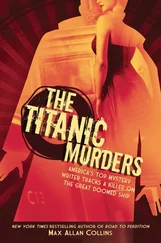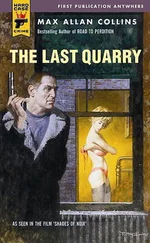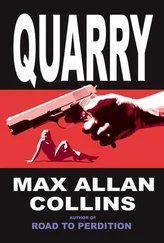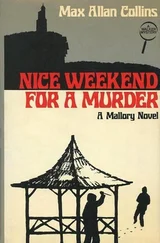Max Collins - No Cure for Death
Здесь есть возможность читать онлайн «Max Collins - No Cure for Death» весь текст электронной книги совершенно бесплатно (целиком полную версию без сокращений). В некоторых случаях можно слушать аудио, скачать через торрент в формате fb2 и присутствует краткое содержание. Год выпуска: 2012, Издательство: AmazonEncore, Жанр: Криминальный детектив, на английском языке. Описание произведения, (предисловие) а так же отзывы посетителей доступны на портале библиотеки ЛибКат.
- Название:No Cure for Death
- Автор:
- Издательство:AmazonEncore
- Жанр:
- Год:2012
- ISBN:нет данных
- Рейтинг книги:4 / 5. Голосов: 1
-
Избранное:Добавить в избранное
- Отзывы:
-
Ваша оценка:
- 80
- 1
- 2
- 3
- 4
- 5
No Cure for Death: краткое содержание, описание и аннотация
Предлагаем к чтению аннотацию, описание, краткое содержание или предисловие (зависит от того, что написал сам автор книги «No Cure for Death»). Если вы не нашли необходимую информацию о книге — напишите в комментариях, мы постараемся отыскать её.
No Cure for Death — читать онлайн бесплатно полную книгу (весь текст) целиком
Ниже представлен текст книги, разбитый по страницам. Система сохранения места последней прочитанной страницы, позволяет с удобством читать онлайн бесплатно книгу «No Cure for Death», без необходимости каждый раз заново искать на чём Вы остановились. Поставьте закладку, и сможете в любой момент перейти на страницу, на которой закончили чтение.
Интервал:
Закладка:
I wasn’t cheered up; it wasn’t like I hadn’t tried to be. I just wasn’t.
Brenda started me with January, 1930, and half an hour later I was beginning January, 1931, and had yet to see the name Simon Harrison Norman in print.
“Reading the old comic strips again, Mr. Mallory?”
I looked up from the machine. It was Miss Simmons, an elderly, attractive lady who’d been head librarian for as long as I could remember. She was the kind of “old maid” who makes it difficult to understand how she got that way; in Miss Simmons’s case, so gossip went, her true love had died in the Great War. Whichever war that was.
“Frankly, Miss Simmons,” I said, “I’m trying to avoid the comics, though I find them and the old movie ads tempting. I’ve got more serious research on my mind.”
“What subject, Mr. Mallory?”
“A local recluse of sorts. Rich recluse. Simon Norman.”
“Ah, Mr. Norman.” She smiled a small, mysterious smile, a smile out of a Gothic novel, and said, “Quite a personality, our Mr. Norman. But you won’t find much of him in the pages of the Port City Journal. ”
“Oh?”
“That is, outside of, perhaps, a scathing editorial or two.”
“Why’s that?”
“Mr. Norman was competition. He was publisher and editor of his own daily newspaper, the Midwest Clarion, which gave the Journal a run for the money. The Journal saw fit to exclude coverage of Mr. Norman in their pages.”
“No kidding,” I said. I looked at the microfilm machine and the box of spools beside it. “But it does present a problem for me.”
“Yes, of course. And for a long time now, Mr. Norman has displayed a distinct dislike for publicity, so recent write-ups are few and far between. You could check the Reader’s Guide for national coverage, but our magazine collection of the thirties is quite limited.”
“You wouldn’t have microfilm files on the Clarion? ”
“No. None have survived to be filmed.”
“And nothing on him in recent years? What about during his son’s political campaigns?”
“Well, there were some attempts to smear the Norman boy by dredging up his father’s misdeeds. But such reports would hardly be objective. Besides, most of the newspapers in the state-the Journal and the Register included-supported young Norman and declined giving detailed accounts of the speeches that included such smears.”
“Well.”
“You seem disturbed, Mr. Mallory. More disturbed than problems with a research paper might warrant.”
“This isn’t a research paper I’m working on. This is something more important than that.”
She thought for a moment, then said, “I think I can help you.” She turned away and disappeared into her office.
Five minutes later, while I was standing flirting with Brenda, Miss Simmons came up to us, gave her employee a sharp look that was mostly pretense, and handed me a small, square magazine. The magazine was marked with a white shard of paper.
“If you can tear yourself away from Miss Halwin,” Miss Simmons said, “and rekindle your enthusiasm for research, this should prove sufficient.”
I did, and it did.
TEN
The magazine was called the Periodical of Iowa History, was dated four years ago, and in an article called “Port City’s Millionaire Cancer Quack” had this to say:
Port City has had more than its quota of controversial citizens during its century-and-a-half history.
One local character spread his controversial nature nationwide: Simon Harrison Norman, “Doc Sy,” operator of a “cancer clinic” in Port City. Norman lives there to this day, in a seclusion markedly contrasting his days as a flamboyant con man, when he drove around the state of Iowa in his purple Cadillac and matching color shirt.
“Doc Sy” was not a doctor, of course… he didn’t even make it out of the eighth grade. But higher education was no barrier for Simon Harrison Norman.
Cancer is Cured
By a skillful if crude manipulation of mass media, Norman drew thousands of the despairing and desperate to Port City in the early thirties, with his slogan “Cancer is Cured” as a lure.
He printed his magazine TKO (Truth Kills Obstacles) and operated radio station KTKO, using Port City as his base. According to his magazine, “Doctor Norman has proven beyond any doubt that even the worst, so-called ‘terminal’ case of cancer can be cured.” Open air meetings, attended by as many as 40,000 persons (five times the size of Port City at the time), watched the showman Norman, an ex-stage hypnotist, perform his miracles.
His purple Cadillac and purple shirt became trademarks of Norman’s when he moved his rallies to towns all through Iowa, touching at times Illinois, Nebraska and Wisconsin.
Such activities brought money in by the barrelsful. The “clinic” reaped profits of $50,000 a month by 1932, and Norman boasted around that time that his “personal consultations” netted him $30,000 on an average week. That these profits were plucked from desolate, poverty-torn Depression families mattered not to Norman. Asked in 1934 by a Des Moines Register reporter how he (Norman) could live with himself after victimizing destitute families, Doc Sy said, “There are no ‘victims’ at the Norman Clinic-only cured, healthy patients, ready to embark on a new life-which my staff and I have given them.”
Norman “gave” nothing-one fifteen-year-old Waterloo boy in later years reported paying Norman’s $100-a-week fee for the “treatment” of his father; comparable rates in a reputable hospital of the era, staffed by physicians, would be around $30 a week. The father, of course, died, in spite of Norman’s treatments and injections. One man used by Norman in a radio broadcast as “living proof of our miraculous cures” died within a month. The man’s wife later said that they had paid $300 for the cure, against the advice of their family doctor, who told them the case was without hope.
A photo story in TKO called “Ten ‘New’ Men,” reporting on a number of “successful” Norman patients, included two who didn’t live long enough to see the article reach print.
Quack King
When an American Medical Association spokesman said, “Of all the heartless, vicious ghouls preying on the dead and those who are about to die, Simon Norman is quack king,” Norman took it as a compliment. Over the door of his clinic he hung a sign saying, “Docs quack-Quacks cure.”
Norman guarded the secret of his “cure” very carefully, once saying, “A well-known doctor devised it for me, before his death,” another time saying, “A traveler to the Himalayas passed it on to me before his untimely demise.” (Norman apparently could cure neither of his benefactors.) Chemists of the day found the “secret” easily unlocked: one Norman concoction was made up of equal parts alcohol and glycerine, with a dab of peppermint oil; a second was nothing more than mineral oil; a third was red clover blossom syrup, which could be purchased in the early thirties for $2 a gallon. Ordinary facial powder served as treatment of external cancer.
Norman was born in Port City and left in his mid-teens to take advantage of his tall, lean good looks-particularly the piercing gray eyes-by becoming a stage hypnotist. In the early twenties Norman was making calliopes on the side, selling them to the circuses, carnivals and riverboats in which he worked his stage act. By the late twenties he was a broadcaster, peddling clocks, brooms, coffee, underwear, flour, tires, furniture and silverware through the magic of radio.
Sometime around 1929, when the fortunes of others were quite low, Norman apparently ran into either the famous doctor or the Himalayan traveler, because by late that year he was on the air pitching his cancer cures. By early 1930, construction had begun on his clinic; by mid-1931, he cut the ribbon on his radio station, and, by early ’33, had his own daily newspaper, the Midwest Clarion. President Herbert Hoover, himself a native Iowan from West Branch, had forged a golden key and sent it on to Norman for him to use to start the Clarion presses.
Читать дальшеИнтервал:
Закладка:
Похожие книги на «No Cure for Death»
Представляем Вашему вниманию похожие книги на «No Cure for Death» списком для выбора. Мы отобрали схожую по названию и смыслу литературу в надежде предоставить читателям больше вариантов отыскать новые, интересные, ещё непрочитанные произведения.
Обсуждение, отзывы о книге «No Cure for Death» и просто собственные мнения читателей. Оставьте ваши комментарии, напишите, что Вы думаете о произведении, его смысле или главных героях. Укажите что конкретно понравилось, а что нет, и почему Вы так считаете.
